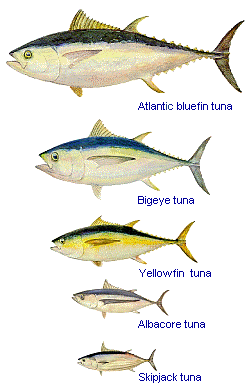Whenever I tell people to eat more fish for the health benefits (omega 3’s, lean protein) the topic of mercury tends to come up. Questions such as “But if I eat more fish, will I be eating too much mercury?” and “Which fish contain a lot of mercury?” are often asked.
In general, the larger the fish the more mercury they are likely to contain. It’s simply because they are higher up on the food chain or they accumulate it over their lifespan. For example, small fish might accumulate some mercury in their system but bigger fish often eat the smaller fish so they tend to have higher levels of mercury.
Here is the official Health Canada recommendation when it comes to mercury in fish:
Limit consumption of fresh/frozen tuna, shark, swordfish, escolar, marlin, and orange roughy. In general, you can eat up to 150 g per week of these fish species combined.
For the most part, the fish that are listed are very large and predatory types. Fresh/frozen tuna is listed but there are many types of tuna (which all vary in size). Blue fin and yellow fin tuna (also known as ahi) are much larger fish and are often used for making sushi and for tuna steaks. They can grow to be over 180 kg in size. Albacore (also called white tuna) and skipjack (also called light tuna) are the ones that are used in canning. Albacore tuna is slightly larger (4.5 kg on average) than skipjack (3.0 kg on average) but not nearly as large as blue fin or yellow fin.
Health Canada indicates that it is safe to eat up to six 170 g cans of albacore/white tuna each week before mercury intake becomes a concern. This works out to eating a full 170 g can of tuna nearly every day. (Highly unlikely, but not impossible). If you ate a full tin of canned tuna every day of the week (although I don’t know why you would ever want to), you could solve the mercury concern by simply switching to canned light tuna/skipjack which is lower in mercury. But I don’t think eating the same thing every single day is generally a good habit and wouldn’t encourage it.
However, there are specific limits placed on vulnerable populations (pregnant women, children, infant, etc). Health Canada recommends the following:
Women who are or may become pregnant and breastfeeding mothers may consume up to 300 g (four Food Guide servings) a week of albacore tuna. This is equivalent to about two 170 g cans of albacore tuna per week. Children between the ages of 5 and 11 years of age may consume 150 g (two servings or about one 170 g can per week) and children 1 to 4 years of age may eat 75 g (one serving or about ½ of a 170 g can per week). Note that there are approximately 120 grams of tuna meat in a 170 g can of tuna after the liquid is drained.
So in general, eat fish! I hope that I’ve helped to clarify this information and it will allow you to make an informed choice when it comes to eating fish and seafood. Here is the bottom line:
- Go ahead and enjoy canned tuna as a quick and easy way to add more seafood and omega-3’s into your diet.
- In general, canned tuna is safe to eat for adults (but if you are part of a vulnerable population, you may have to limit your intake).
- Choose light tuna/skipjack and a variety of fish and seafood (smaller fish such as salmon, trout).
- Aim for two servings of fish per week and aim for variety.
For more information, check out Health Canada’s fact sheet on Mercury in Fish.

